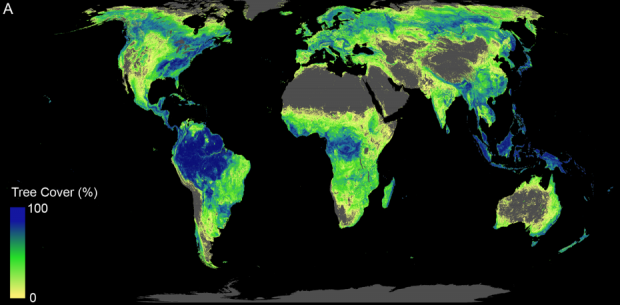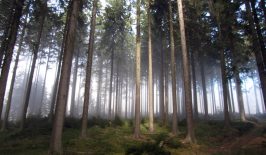If we want to slow down climate change, we need to take drastic measures. As a first priority, we need to significantly reduce our emissions of CO2 and other climate-damaging gases – in all areas of our life. But we also need to filter out the CO2 that we have already released into the Earth’s atmosphere or – failing that – at least reduce it to a more climate-friendly level. While on the one hand we are tinkering with high-tech solutions of how to remove some of the CO2 that we’ve already emitted, we can’t afford to forget that there are also a huge number of nature-based solutions. A new study has (once again) drawn attention to the power that lies in our silent fellow inhabitants on this planet: trees.
It has long been known how important forests are both for the microclimate in individual regions and for the Earth’s climate as a whole. They “feed” on CO2 and convert it into oxygen, which is vital for our survival. A team of researchers at ETH Zurich has investigated that further and come up with some some interesting figures:
Two thirds of man-made CO2 emissions could be removed from our atmosphere if we were to reforest 900 million hectares of forests worldwide
The study was carried out at the Crowther Lab at ETH Zurich, where research is being carried out into nature-based solutions to climate change. For their study, the researchers used satellite and field data to scan the globe to see where new trees could grow and how much carbon they would store. The researchers have set new methodological standards: calculating the potential of reforestation with the aid of artificial intelligence. Prof. Dr. Felix Creutzig, head of the Working Group on Land Use, Infrastructure and Transport at the Mercator Research Institute on Global Commons and Climate Change (MCC) in Berlin stated:
“This makes it much easier to take geographical differences into account. This also shows that artificial intelligence offers great potential for climate science and especially for mitigating climate change.”
The researchers came to the conclusion that given current conditions, the Earth could be covered with around 4.4 billion hectares of forest – i.e. 1.6 billion more than the current 2.8 billion hectares. Of these 1.6 billion hectares, 0.9 billion hectares meet the criterion of not being used by humans. As Jean-François Bastin, Head of Studies and Postdoc at the Crowther Lab, explains in a press release of ETH Zurich, “Cities and agricultural land have been excluded from the entire area with the potential for reforestation, because these areas are needed elsewhere by humans.” This means that an area the size of the USA would currently be available for reforestation. Once the new forests have grown, they could store 205 billion tonnes of carbon – about two-thirds of the 300 billion tonnes of carbon that we humans have pumped into the atmosphere since the Industrial Revolution.
 © Total available area which could be used for growing trees – including both current forest areas and areas suitable for reforestation.
© Total available area which could be used for growing trees – including both current forest areas and areas suitable for reforestation.ETH Professor Tom Crowther, co-author of the study and founder of the Crowther Lab explained:
“We all knew restoring forests could play a part in tackling climate change, but we had no scientific understanding of what impact this could make. Our study shows clearly that forest restoration is the best climate change solution available today and it provides hard evidence to justify investment…However, it will take decades for new forests to mature and achieve this potential. It is vitally important that we protect the forests that exist today, pursue other climate solutions, and continue to phase out fossil fuels from our economies in order to avoid dangerous climate change.”
Greatest potential in six countries
The study also shows in which regions reforestation would be most possible. The largest areas are available in only six countries: Russia (151 million hectares), USA (103 million hectares), Canada (78.4 million hectares), Australia (58 million hectares), Brazil (49.7 million hectares) and China (40.2 million hectares).
So is it as simple as starting to plant trees right away? Unfortunately not, as even if the conditions, for example in Russia, are actually optimal, the question arises as to what extent active reforestation can be promoted and carried out. “In contrast to China, for example, there is a lack of technical resources, manpower and reliable institutional support for such measures,” says Dr. Marcus Lindner, senior scientist in the Resilienz Research Unit at the European Forest Institute (EFI) in Bonn. In all other countries, too, a strong political will is needed for such large-scale forest plantations. Unfortunately, individual tree plantings will not result in a forest for a very long time.
And time is ticking. New forests need time to grow until they can absorb relevant amounts of CO2. And as the authors of the study point out, the area that they calculated shrinks more and more as reforestation is delayed. As climate change progresses, less and less land is available around the world that is suitable for developing forest habitats.
World rescue = Forest rescue
While trees are being planted, at the same time, forests are being cut down. It might sound contradictory, but it’s a global reality. And it’s why many experts stress that we shouldn’t only focus on reforestation measures, but at the same time stop deforestation of huge areas and invest in resilient forests, especially in Brazil and Indonesia.
The issue of deforestation is a complex one. European meat and dairy production, for example, also plays a decisive role. Poultry, pigs and cattle are mainly fed with soya grown on Brazilian soil – which was previous rainforest before being cleared for agriculture. “Consumers can therefore make their contribution by limiting meat consumption. The Federal Ministry of Agriculture should detach itself from the agricultural lobby and push ahead with a rapid and complete conversion to ecological and species-appropriate agriculture, which requires significantly less soya as animal feed,” explains Prof. Dr. Felix Creutzig.
But it is not only the need for agricultural land that is causing our forests to shrink. Many forests worldwide are weakened by monocultures – the same species of tree appearing in abundance in the same forest – which makes them more susceptible to diseases, pests and forest fires. Globally, it must therefore be a matter of making forests more resilient through appropriate measures. In Germany, for example, this means transforming the highly fire-prone pine forests – which are particularly common in north-eastern Germany – into less susceptible mixed forests. However, at present, this is not being consistently pursued.
Reforestation alone is not a magic pill that can resolve the issue of climate change over night, but combined with other measures, such as the conservation of existing forests, it is an important part of the solution. Let’s hope that the results of the study will raise consciousness for the potentials of reforestation and that governments around the world will implement far-reaching measures to protect existing forests and allow new ones to grow. But we don’t have to sit back and wait until then, because:
Reforestation can begin!
A tool on the Crowther Lab website allows users to choose anywhere in the world and find out how many trees could grow there and how much carbon they would store. There you can also find an ever-growing list of forest restoration organizations that you can support. Get involved!
All expert statements are taken from the German language press briefing of the Science Media Center (SMC).
This is a translation by Mark Newton of an original article that first appeared on RESET’s German-language site.






